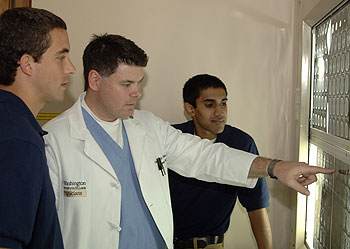Undergraduate students at the University get the good, the bad and the ugly realities of life as a physician through a biology course known as the Med Prep Program.
Greg Polites, M.D., assistant professor of emergency medicine and assistant director of the Emergency Medicine Residency Program, took over as instructor of Biology 3651 in the fall of 2005. Previously, the course was known as the EM-STAR (Emergency Medicine-Scholastic Training and Research) program.

While it gave undergraduate pre-med students the opportunity to participate in clinical research, its focus was much different. The changes in the new course have been met with rave reviews from students.
“When I was revising the curriculum, I thought, ‘What would I have wanted to know when I was 20 about a career in medicine?'” Polites said. “Universities in general do a pretty good job of preparing students for the academic challenges of medical school, but they do a pretty poor job of teaching students what we do on a day-to-day basis or what to expect in the years ahead.
“To accomplish this, I took out every bit of what I considered unnecessary ‘busy’ work, giving the students only high-yield, practical information that would help clarify the next decade of their lives.”
Polites, a member of the School of Medicine’s admissions committee, said he designed the course’s curriculum to give students detailed information regarding every step of the medical education process from the day students apply to medical school to the day they become board-certified specialists. “By the time they are done, I want them to have an accurate, realistic view of what it takes to be a physician,” he said.
The course includes a weekly two-hour lecture, covering topics such as the dos and don’ts of the application process to the attitude that’s expected by medical school professors. There are also question-and-answer sessions with residents from eight specialties who discuss the pros and cons of their specialties, the training time involved and the lifestyle both during and after residency.
Vikram Sasi, a senior pre-med student who comes from a family of physicians, said at first, Polites’ requirements for the class seemed stringent.
“In the beginning, Dr. Polites instilled in everyone’s minds that when you are shadowing, you have to behave like an actual resident,” he said. “He let us know that if we were late (to rounds while in medical school), we’d be castigated in front of everyone.”
Polites said he talks about all of the pluses and minuses of a life in medicine.
“Why sugar-coat it? I tell them the good and the bad aspects of being a physician and even some things they wouldn’t expect to hear,” he said. “This class is excellent for someone who is ‘on the fence,’ trying to decide if medicine is right for them.”
In addition, students get to shadow Polites and other physicians in the Emergency Department at Barnes-Jewish Hospital for three hours each week. While the students don’t work with patients, the experience is designed to give them a behind-the-scenes look at how medical students and residents are trained at a major teaching hospital.
“The purpose of shadowing is not to teach medicine,” Polites said. “It’s to give the students exposure to the lifestyle and to see the thought process we use in treating both routine medical problems and life-threatening conditions. The students come into every room and see everything we do with the patients. They all take with them a different perspective.”
Sasi said although he had already decided to go into medicine, the class enhanced his perspective on the realities of being a physician.
“As an undergrad, the experience was mindblowing,” Sasi said. “To be able to go to Barnes-Jewish Hospital’s Emergency Department, a Level 1 trauma center, as an undergraduate student and swipe in like any other physician and watch medicine happening right in front of you — it’s exhilarating.”
One point Polites said he tries to drive home is that being an excellent physician requires more than just a good memory and test-taking skills. “It requires humility, a commitment to continued learning and a degree of selflessness that is found in few other professions,” he said.
The class is growing by leaps and bounds, partly due to word of mouth from students who have already taken the class and their devotion to Polites. The fall class has 85 students enrolled.
“Dr. Polites is just amazing,” Sasi said. “When he’s handling a patient, he’s always explaining what’s going on to make sure we understand. Every student adores him.”
Ian English, a junior pre-med major, said Joan Downey, M.D., assistant professor of pediatrics and assistant dean, College of Arts & Sciences, suggested he take the class because he wasn’t sure that medicine was right for him.
“I think it was the best thing to help me make the decision to apply to medical school,” English said. “You really can’t understand if you’ll like medicine from a chemistry class. This class definitely helped me understand that it’s something I want to do.”
English described Polites as a Renaissance man. “He knows a little about everything,” he said. “He’s a perfect teacher because he’s young enough to be able to relate to us, but he also knows everything the residents are going through.”